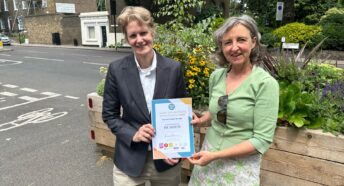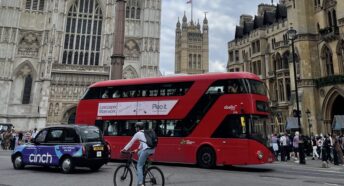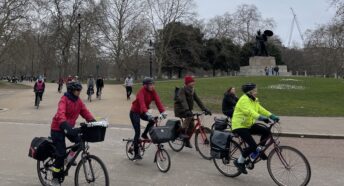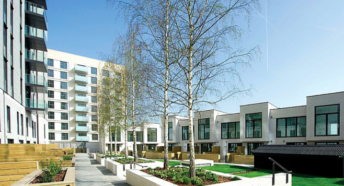Postcode lottery for walkers, cyclists and healthy streets claim campaigners
New scorecard shows wide variation between London boroughs’ progress towards the Mayor’s key transport targets.
Postcode lottery for walking and cycling and healthy streets, claim campaigners producing first ever “London Boroughs Healthy Streets Scorecard”.
A coalition of transport campaigners [1] in London (London Living Streets, London Cycling Campaign, CPRE London, RoadPeace, Sustrans and Campaign for Better Transport London) has today Monday 15 July 2019 published a scorecard [2] showing wide variation in boroughs’ progress towards the Mayor’s Transport Strategy ‘healthy streets’ targets.
While some boroughs such as Tower Hamlets and Camden in Inner London and Waltham Forest in Outer London, are rapidly progressing schemes to cut car use and road danger, and boost air quality and walking and cycling rates, others such as Kensington & Chelsea and Havering have yet to take key measures that start to put people, not cars, first. [FULL RESULTS SEE NOTE 3]
In 2018 the Mayor of London published a bold new “Transport Strategy” committing London to a future where car use is far lower, people walk and cycle more, residents are more active, air quality is far better and road danger far lower.
London’s boroughs control 95% of London’s roads so what they do really matters. But while some are now taking action, others are doing far too little.
As a result, the scorecard reveals that while 93% of journeys made in some boroughs by their residents are done by walking, cycling and using public transport, that can be as low as 41% in others, with the bulk of the remainder of journeys made by car. Similarly, in some boroughs over half of residents walk or cycle more than five times a week to keep active, but in others only just over a quarter manage it.
The scorecard also tracks some key changes to streets that boroughs can make easily and affordably, and in a short space of time which will make a big difference. While one borough has installed 84 “modal filters” (barriers to cut out rat-running, or through motor traffic) in just a few years, another has only ever installed two. And 20mph coverage of borough roads varies from nearly 100% to just 10%. Similarly, there are boroughs where every street is part of a “controlled parking zone”, but other boroughs where less than 10% of streets are covered.
The organisations in the London Boroughs Healthy Streets Scorecard Coalition hope that the research will help the boroughs identify areas for improvement and look forward to supporting them to make the necessary changes.
Jeremy Leach, Chair London Living Streets said: “Boroughs are central to the delivery of the Mayor’s healthy streets targets and there a number of measures they can bring in right now to achieve dramatic results in terms of improving health and activity, reducing danger on the roads and helping the environment. The Scorecard shows progress in implementing these measures, but boroughs have to do far more to reduce car usage, charge for parking properly and get more people walking and cycling.”
Dr Ashok Sinha, Chief Executive, London Cycling Campaign said “People’s access to streets that are safe enough to take the healthy option of cycling has long been a postcode lottery. But our data shows the gulf is widening further between the most progressive boroughs, such as Waltham Forest, the City and Camden, and the rest. Every London borough should study this scorecard and take action: the best can and should improve further still, and the rest can and should rise to the challenge of guaranteeing their residents cleaner air to breathe and safer streets in which to walk and cycle.” Dr Ashok Sinha, Chief Executive, London Cycling Campaign.
Alice Roberts of CPRE London said: “Road traffic has a massive impact on our physical and mental health and it is literally fueling our climate emergency. Fumes, noise and road danger affect us on a daily basis and discourage walking and cycling which can make us fitter and healthier. Our Scorecard shows that there is plenty that boroughs can do to improve the situation. We want to promote action and we need Londoners to encourage and support boroughs to make the necessary changes.”
Nick Simmons, CEO of RoadPeace, said “Our streets will not be safer or our lives healthier without greater commitment from the boroughs. This scorecard should help boroughs deliver Healthy Streets which would spare families the devastation of road death and serious injury.”
Matt Winfield, Director for Sustrans in London, said: “At a time when air pollution kills thousands of Londoners each year, congestion throttles our streets and the Mayor has declared a climate emergency, Healthy Streets are not just nice to have, they are essential. The vast majority of the streets in London are managed by Boroughs and the onus is on them to make sure our streets are designed for people.
“We are inspired and excited by what some boroughs have already delivered and what other boroughs are currently planning, but three years into this Mayoral term more urgency is needed to make it easier for people to walk and cycle all across London.
“This baseline research is an important step in helping councils and residents identify local Healthy Streets priorities, and future updates will shine a light on the achievements of those working on this agenda right across London.”
Chris Barker from the Campaign for Better Transport London said: “The Campaign for Better Transport is focussed on encouraging people to leave their cars at home and adopt a healthy lifestyle. This is why we wholeheartedly endorse the launch of the Healthy Streets Scorecard. It is an excellent way to encourage boroughs to do more to promote healthy forms of transport.”
ENDS
Notes
[1] Campaigners in the Healthy Streets coalition are CPRE London, Living Streets London, London Cycling Campaign, RoadPeace, Sustrans and Campaign for Better Transport London
[2] The London Boroughs Healthy Streets Scorecard report (which contains charts for each indicator), along with a spreadsheet with full data sets, is available at
https://lcc.org.uk/articles/healthy-boroughs
OR
http://www.cprelondon.org.uk/resources/item/2454-healthystreetsscorecard
AND will be made available on the websites of all the organisations in the coalition listed above in due course.
[3] The chart below shows the London Boroughs Healthy Streets Scorecard – OVERALL SCORES FOR 2019 (YELLOW = Outer London borough, BLUE = Inner London borough). The overall scores were derived by combining scores from the eight individual indicators. See Annex 2 (see p21) for charts, data sources and methodology for individual indicators and overall Healthy Streets Scorecard.
If we exclude the City of London, the boroughs of Tower Hamlets, Camden and Hackney scored highest and the lowest scoring borough was Havering closely followed by Redbridge, Bexley, Bromley and Hillingdon.
Results for 4 output indicators: The London Mayor has targets to reduce car trips, increase walking and cycling and reduce traffic collisions but London’s boroughs control 95% of London’s roads so what they do really matters. On individual indicators:
- The proportion of trips made by either public transport, walking or cycling ranges from 41% in Hillingdon to 85% in Hackney. (The Mayor’s target is 75% in Outer London and 90% in Inner London by 2041.)
- The proportion of people walking or cycling more than five times a week varies between 27% in Barking and Dagenham and 56% in Hackney. (The Mayor’s aim is, by 2041, for all Londoners to do at least the 20 minutes of active travel they need to stay healthy each day.)
- The highest number of serious injuries for active travellers per million journey stages was in Hackney and was roughly three times the lowest rate in Greenwich. (In 2018, TfL launched its Vision Zero Action Plan to meet a target that, by 2041, no one would be killed or seriously injured on London’s roads.)
- There is a dramatic difference in reliance on cars with three and a half times more cars registered per household in Hillingdon (1.27) than in Islington (0.35). Though there is no Mayoral target for car ownership, this score reflects the extent to which people are reliant on cars.
Results for 4 input indicators The scorecard also tracks whether boroughs are making changes to their streets. It tracks four measures which can be implemented easily and affordably, in one or two years and which evidence shows can lead to big shifts towards the targets.
- ‘Low Traffic Neighbourhood’ schemes are where through-traffic is blocked from residential streets using modal filters. The most are in Hackney (84) and the fewest in Kensington & Chelsea (2).
- 20mph speed limits are widespread in some boroughs with nearly 100% of streets covered in Southwark, Hackney and Islington but only 10% of streets covered in many other boroughs including Bromley, Barnet and Kensington & Chelsea.
- The proportion of streets with controlled parking varies between 100% in Camden and Kensington & Chelsea to below 10% in Bromley, Enfield and Sutton.
- There are also wide differences in the amount of protected cycle track: Westminster, Tower Hamlets and Enfield have the longest lengths installed; Croydon, Brent and Kensington & Chelsea the shortest.
Contacts for further information
London Living Streets – Jeremy Leach, 07415 243 015 / Emma Griffin 07960 587 030
London Cycling Campaign – Simon Munk 020 7234 9310
CPRE London – Alice Roberts 07792 942 691
Sustrans – media contact 020 7780 7231
Campaign for Better Transport London – Chris Barker, 07951 905 493
RoadPeace – Amy Aeron-Thomas 020 7733 1603







